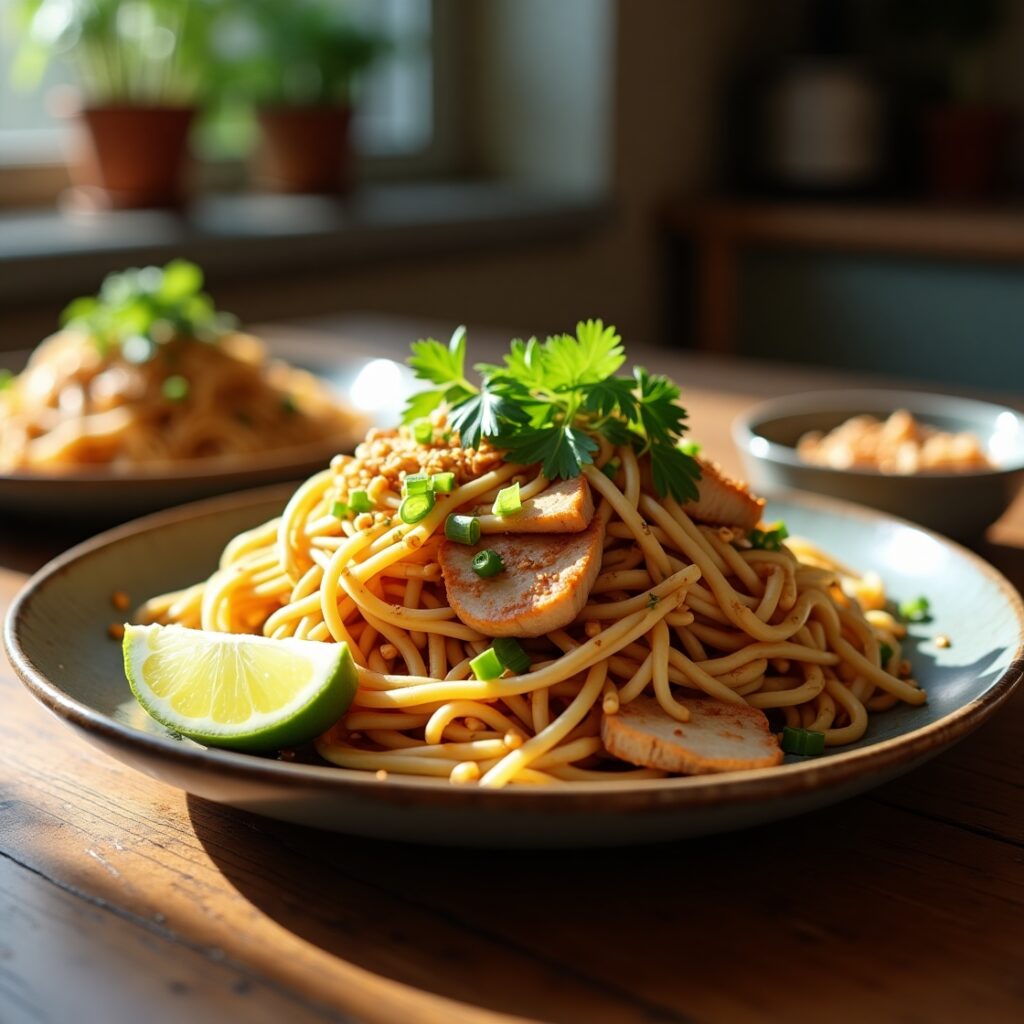Pad Thai is a classic Thai stir-fried noodle dish known for its vibrant flavors and satisfying texture. Made with rice noodles, a tangy-sweet tamarind sauce, crunchy peanuts, and fresh vegetables, it often includes shrimp, chicken, or tofu. This street food favorite is quick to make and packed with the perfect balance of savory, sweet, sour, and spicy notes.
Ingredients
For the Pad Thai Sauce:
-
3 tbsp tamarind paste
-
3 tbsp fish sauce (or soy sauce as a vegetarian substitute)
-
2 tbsp palm sugar or brown sugar
-
1 tbsp rice vinegar
-
1 tsp chili powder (adjust to taste)
For the Noodles:
-
200g (7 oz) flat rice noodles
-
2 tbsp vegetable oil
-
2 garlic cloves, minced
-
2 shallots, thinly sliced
-
150g (5 oz) chicken breast, shrimp, or tofu, sliced
-
2 eggs, lightly beaten
-
1 cup bean sprouts
-
1/2 cup green onions, chopped
-
1/4 cup crushed roasted peanuts
-
1 lime, cut into wedges
Execution
-
Prepare the Noodles
Soak rice noodles in warm water for 20–30 minutes or until pliable. Drain and set aside. -
Make the Sauce
In a bowl, mix tamarind paste, fish sauce, sugar, rice vinegar, and chili powder until sugar dissolves. Set aside. -
Cook the Protein
In a wok or large pan, heat 1 tbsp of oil over medium-high heat. Add garlic and shallots; sauté until fragrant. Add chicken/shrimp/tofu and cook until done. Push to the side of the pan. -
Scramble the Eggs
Add the remaining oil, pour in eggs, scramble them, and mix with the protein. -
Stir-Fry the Noodles
Add the noodles and sauce. Toss everything together for 2–3 minutes until noodles are cooked and coated. -
Finish with Veggies
Add bean sprouts and green onions. Stir-fry briefly (about 30 seconds). -
Serve
Dish up hot, finish with a sprinkle of peanuts, and serve with lime wedges.
Additional Tips
✔ Tamarind paste is available in most Asian grocery stores. To make a fast alternative, mix lime juice with a hint of sugar.
✔ Don’t over-soak noodles; they will finish cooking in the pan.
✔ Add Thai red chili flakes for a spicier version.
✔ Garnish with fresh cilantro and extra bean sprouts for crunch.
Q&A About Pad Thai
Q: Can I make Pad Thai vegetarian or vegan?
A: Absolutely! Instead of fish sauce, use soy sauce (or tamari), and replace meat with tofu. Feel free to bulk it up with extra veggies like bell peppers, carrots, or mushrooms.
Q: What is tamarind paste and can I substitute it?
A: The distinctive sweet-tangy flavor of traditional Pad Thai comes from tamarind paste. If you don’t have it, lime juice and brown sugar can work as a substitute, though the flavor won’t be quite the same.
Q: Would a different type of noodle work instead?
A: Traditional Pad Thai uses flat rice noodles, but in a pinch, you can use fettuccine-style pasta or even ramen noodles. The texture will change slightly, but it can still be delicious.
Q: Is Pad Thai spicy?
A: Pad Thai has a mild spice level by default. You can adjust the heat by adding more or less chili powder or serving it with crushed red pepper on the side.
Q: Is it possible to prepare Pad Thai in advance?
A: It’s best served fresh, but you can make it ahead and reheat it. Keep the peanuts and lime separate until serving to maintain freshness and texture. Reheat in a pan with a splash of water to revive the noodles.
Q: How do I prevent the noodles from sticking together?
A: Soak the noodles just until pliable, and rinse them with cold water before stir-frying. Toss them in a bit of oil if you’re prepping ahead. Avoid overcooking in the pan.
Q: Can I freeze Pad Thai?
A: Freezing Pad Thai isn’t ideal, as the noodles can become mushy when thawed. If needed, freeze only the sauce and protein components and cook noodles fresh.
Q: What toppings or garnishes go best with Pad Thai?
A: Crushed peanuts, lime wedges, fresh cilantro, extra bean sprouts, and chili flakes are all excellent toppings. Spice lovers can finish with a drizzle of sriracha for an extra punch.
Why You Should Make Pad Thai
✅ Quick and Easy
This recipe comes together in just 40 minutes, making it perfect for busy weeknights. With simple steps and easy-to-find ingredients, you don’t need to be a professional chef to nail it.
✅ Authentic Thai Flavor at Home
Enjoy the bold, balanced flavors of sweet, sour, salty, and spicy without leaving your kitchen. With this homemade tamarind sauce, you’ll get that signature restaurant-quality taste right in your kitchen.
✅ Customizable to Your Taste
Whether you prefer chicken, shrimp, tofu, or all-veggie, this recipe adapts to your dietary needs and cravings. It’s easy to make vegetarian, vegan, or gluten-free.
✅ Healthy and Fresh
Packed with fresh vegetables, lean protein, and a moderate amount of healthy fat, this dish is a wholesome alternative to takeout. Plus, you control the ingredients—no MSG or hidden sugars.
✅ Great for Meal Prep
Make a larger batch and enjoy delicious leftovers. It reheats well and keeps in the fridge for 2–3 days, making lunch planning effortless.
Nutrition Facts (per serving)
-
Calories: 520 kcal
-
Total Fat: 18g
-
Saturated Fat: 3g
-
Trans Fat: 0g
-
-
Cholesterol: 135mg
-
Sodium: 950mg
-
Total Carbohydrates: 60g
-
Dietary Fiber: 3g
-
Sugars: 12g
-
-
Protein: 28g
Vitamins & Minerals
-
Vitamin A: 8% DV
-
Vitamin C: 10% DV
-
Calcium: 6% DV
-
Iron: 15% DV
-
Potassium: 400mg
Notes:
-
Values may vary based on portion size and specific ingredients used (e.g., amount of oil, type of protein, sugar level in tamarind paste).
-
Using tofu instead of chicken reduces cholesterol and increases calcium.
-
For a lower-sodium version, reduce fish sauce or use low-sodium soy sauce.
Happy Cooking
Diana



